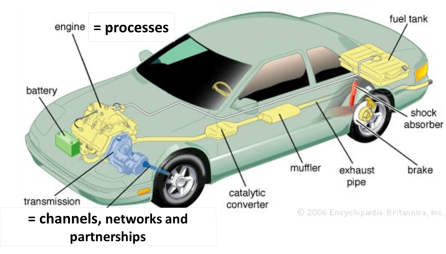This is the concluding part of a talk that I gave at the 18th ASPLI Summit at Sugarland Hotel in Bacolod City last September 21, 2017. The topic of the talk is How to be a Champion Leader: Business Success through Best Execution.
Why do process improvements projects fail?
Many process improvement initiatives not so much fail as fail to keep up. That’s because organizations do not stay still and keep moving: new laws and regulations are put in place, our customer’s tastes and needs evolve, and our pesky competitors keep on doing new things. The pace of change is accelerating. Hence, the upsurge in interest in agile process improvement. (On a side note, there is an important distinction between the completion of a project or a sprint and the realization of productivity gains which I make in a previous blog.)
More importantly, the cornerstones of efficiency programs in the past – which are clarity, measurement and accountability – do not yield significant productivity gains the way that they have done in the last few decades. This is because most businesses are not linear value chains anymore.
In today’s networked world, the number of essential organizational connections has multiplied. The need for our teams (as well as external partners) to work together better has never been more important. Thus, some degree of complexity is inevitable. However, the added complexity can often run counter to the need for greater adaptability.
As a further step, we need to systematically filter out the non-essential complicatedness from the essential organizational complexity. Tackling our execution problems requires recognizing the much wider System at Work beyond the narrower set of end-to-end processes.
The car as an analogy for a system at work
In much the same that a car has an engine, a transmission system, an electrical system, a dashboard and so on and so forth, an organization has structural elements or dimensions on top of the set of end-to-end processes.

If the analogy works, can a car expert be a good manager then?
Any envisioned change to a process will have ripple effects on the other organizational dimensions. The Boston Consulting Group has tried to describe the System at Work in terms of eight dimensions. I have a slightly different view of the eight dimensions which I describe in the next chart (viz.: Stewardship; Channels, networks and partnerships; Organization structure; End-to-end processes; Systems, tools and technology; performance management; Roles and interactions, and; Talent management).
Each of the organizational dimensions will have hard aspects or discrete structural elements as well as the soft aspects, addressing capability and behaviors. (Following the analogy of the car, the soft aspects relate to working on having good drivers, navigators and mechanics.)
A Champion Leader is one that can seamlessly bring all the dimensions together and drive and align behaviors of the individuals and teams involved. A Champion Leader understands the power of elegant simplicity in organizational design.
Eliminating complicatedness
Striving for simplicity in the System at Work is a two-step activity:
- We begin by understanding the symptoms and root causes of complicatedness (Side note: Many process management experts caution that the true first step in “outside-in” design is having a conversation with the customer. For our purposes, we presume that the customer is well understood and that we are now at the point of organizational streamlining.); then
- Finding solutions that address all relevant dimensions – not just process alone – and addressing both the hard and soft aspects of those dimensions.

Finding solutions (the second step) will naturally start with process review in order to anchor the effort on the organization’s value creation activities. Our lean-six sigma teams know how to design the structural elements very well: strive for the least number of steps, the least number of hand-offs across teams, and the least effort by customers to get their product or service, etc..

Process improvements need to be continuous in adaptive organizations and as such potentially exhausting for our people unless the organization’s behaviors and culture allow for such dynamism and adaptation, essentially equipping our people with the ability to make things happen. This means that the organizational DNA should incorporate the following behaviors and capabilities, among others:
- Quickness to address the obvious things;
- Never waiting for someone else to give permission to fix the problem;
- Belief that there is a better way; and
- Recognizing when the changes you’ve introduced do not work (This is important if, like Elon Musk, you intend to fail early and often.)
Organizations sometimes attempt to shape the behavioral aspects of process improvement with re-organization (coming up with faddish organizational units such as squads, crews, troops or tribes) as a way to detach from the old way of doing things. Introducing process change that will end up adding more boxes to the organization chart has a way of adding complicatedness whenever the change entails more matrices, more KPIs, and more reports.
It is not uncommon for companies to fail to perform the commensurate review of the other organizational dimensions. When this happens, there is a risk that the process simplification may result in System at Work sub-optimization. Let’s touch briefly on two of the other dimensions to better appreciate their the connectivity with process:
- Roles
We need to assess whether the process improvement allows a manager or supervisor to delegate down without commensurately increasing the burden of reporting (on the part of the subordinate) and supervision (on the part of the manager) and adding to the number of rules in place.

The more the manager can delegate, the more responsive the process becomes and the less likely will more process changes be required in the foreseeable future.
The optimal level of delegation increases the total quantity of power and allows organizations to be more adaptive to constantly changing competitive circumstances. Hence, the buzz word empowerment. Empowerment energizes our teams.
- Organization structure
Earlier I mentioned that process change that adds boxes to the organization chart is far from ideal. Beyond that, we want to encourage cooperation and team work across functional teams involved in any given process, say between the Accounts Payable Team and the Finance Team, between Product Planning and Sales, between the Logistics Team and the Stores. There are analogies to the Insurance business too, say, between Underwriting and Sales and Marketing or between Claims and the Legal Department.
We need to examine whether the lateral relations between teams encourage give and take. If not, do we:
- Change the reporting lines of the teams involved?
- Do we create consistent if not shared performance metrics for the team heads involved?
- Over and above the metrics, is there a steering committee that meets periodically that evaluates the quality of cooperation across teams?
- Do we need to put a job rotation program between the two teams?
This does not mean making people get along by merely going along. Encouraging group think is the exact opposite of what we want.
There is a soft side we need to address which is equipping managers and teams with the emotional stamina to accommodate a great diversity in views in order to arrive at an effective and pragmatic consensus. Emphatic and sometimes brutal critiques may be necessary but should not affect motivation and trust within the organization.
As a final word to guide our System at Work improvements, let me paraphrase a quote from the artist Keith Yamashita: Champion Leaders edit for importance, meaning and simplicity.
Who is a Champion Leader?
To sum up, let us ask that question again: Who is a champion leader?
He is the leader that can cultivate a champion system at work, one that allows the best practices to be replicated in all the relevant corners of the organization:
- He encourages his organization to surrender to the best ideas and find a home for these ideas within their teams. Champion leaders move the organization to band together and implement that new and better way.

- We say that a leader with integrity walks to talk, right? On top of that a champion leader talks the walk.
Karl Weick’s words, “Walking is the means to find things worth talking about” is another way of saying that experimentation (and sometimes failing) is the only way to discover and innovate. This means that the Champion Leader does not penalize failure because he understands that fine line between failure and mistakes. Rather he encourages his people to talk about their experience in order to learn from it.
Which is not to say that he is not tough when he needs to be: He is quick to penalize when people refuse to help or fail to ask for help when they need it.
- Traditional continuous improvement techniques do not address the issues of resiliency and sustainability – champion leaders provide the missing elements which are a sense of purpose, fulfillment and positive relationships.
Champion leaders recognize that the antidote to complexity is the simplicity achieved through vastly better coordination – and in the process creating a whole organization that is worth more than the sum of its parts.
As a final word: is this message meant only for CEOs like Elon Musk? I don’t believe so. In your own teams, there will always be unnecessary complexity that needs to be eliminated, a need for connection and collaboration with other parts of the organization, a need to empower your team members.
On the note, happy journeys on the road to simplification!

